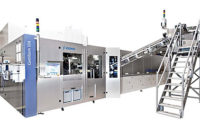Plastic bottle manufacturing breaks the plastic mold
Blow molding machinery responds to demand for flexibility

Krones’ Pro-Shape blow molding machine uses a unique preform tempering concept to mold non-round containers with higher output using less material than other technology, the company says.
When consumers make a purchase at retail, they don’t always consider the lifecycle of the product. In order to end up intact on the shelf, a beverage must survive a variety of obstacles — one of which is blow molding.
In addition to manufacturing precisely formed bottles, many other demands are taken into consideration with blow molding machinery.
“Over the last few years, [there have been] more concerns in [total cost of ownership] and higher quality that require higher output speeds and lighter weight containers to improve savings,” says David Raabe, director of blow molding for North America and key accounts for the converter business in North America with Krones Inc., Franklin, Wis.
Fulfilling these needs, Krones’ plastic division developed several platforms. Its C3 platform runs 2,250 cavities an hour with a new feature of air saving and servo drive controls, he says. Offering energy savings, which in turn lowers the carbon footprint, Krones’ Ergo bloc concept includes a blow molder, labeler and filler encompassed in one platform. Specializing in lighter-weight materials is the company’s Pro-Shape machine, which uses a unique preform tempering concept to mold non-round containers with higher output and less material than other technology, he adds.
“[The Pro-Shape machine is] very prescribed and it’s very precise; therefore, we can run lighter weight containers, and we can do this at higher output speeds than what traditionally has been out there in the market,” Raabe says.
Overall, the company’s blow molding machinery offers between eight and 40 cavities for a wide variety of beverage applications, he adds.
Getting flexible and sustainable
Considering the number of innovative beverage packages and plastic types, flexibility is one of the top trends in the blow molding segment — the other is environmental impact, according to Norcross, Ga.-based Sidel.
“Blow molding machines must allow marketing freedom to bottlers in order to enable a wider differentiation in terms of packaging design and product segmentation,” the company explains. This also means better compatibility with new types of resins and packaging shapes, it adds. Sidel’s blow molding machinery produces polyethylene terephthlate (PET) as well as recycled PET, bioPET, polypropylene (PP) and polylactic acid stretch blow molded high-density polyethylene (HDPE) bottles. Container sizes range from 200 ml. to 10 liters, Sidel says.
On the environmental impact side, the trend consists of improving the performance of the equipment to reduce energy, such as reducing blow molding pressure and optimizing ovens, it adds.
For instance, KHS USA Inc., Sarasota, Fla., makes the InnoPET Blomax Series IV stretch blow molder, which offers energy efficiency. The machinery features a space-saving design and compact blow station layout. Energy consumption for production of bottles between 200 ml. and 3 liters is up to 25 percent lower compared with the previous series, the company says. Additionally, its Speed-Loc quick-change system enables operators to perform changeovers quickly and with minimal effort, it adds.
Because most bottlers are seeking flexible blow molding machinery, changeover must be quick, adds Marco Bottecchia, president of SIPA North America Inc., Atlanta. Therefore, blow molding machines have been equipped with new features to accomplish this task — a mold changeover could be done in 45 seconds with no tools, he says.
SIPA’s blow molding machinery includes one-stage technology for special applications; preform production systems; linear blow molding systems for oval containers, large bottles, bottles with handles and small-to-medium volume; and rotary blow molding systems for high-volume production, such as water and carbonated soft drinks.
Its single-stage ECS Integrated Systems range encapsulates the entire blow molding process, from the raw material to the finished bottle, with output up to 600 bottles a minute. Each model in the range also is available in “Flex” version, which allows the machine to produce large-capacity containers up to 30 liters and large necks up to 135 mm. by reducing the machine’s cavitations. It also offers the SincroBloc, which is a compact integrated solution for the production, filling and capping of PET containers; it can handle between 6,000 and 52,800 bottles an hour. The company’s Sincro TriBloc merges production with labeling, filling and capping. Its output ranges from 12,000 to 48,000 bottles an hour.
Sidel’s stretch blow molding machines feature bi-orientation technology and are made up of linear machines, which run up to 7,200 bottles an hour, and rotative machines, which run from 12,000 bottles an hour to 64,600 bottles an hour, the company says.
The company’s most recent introduction is its SBO Compact2 linear blow molding machinery range.
“With its latest SBO Compact2, Sidel consolidated a reliable and robust linear blow-molding machine that improves bottle quality,” the company says. “The final quality of the bottle is determined by the quality of preform stretch blowing using bi-orientation. Throughout this process, the aim is to ensure maximum process precision and repetitiveness while obtaining optimal production speed.”
Because every bottler is different, it is important to define the solution that is most suitable to a company’s production plans, skills and logistics, SIPA’s Bottecchia says.
“SIPA can provide support from the beginning in order to select the most suitable technology,” he says. “A clear explanation on how to operate with a machine, how to manage a changeover and how to properly maintain a system are all key factors to be transferred.”
Additionally, blow molding machinery suppliers continue to see a trend toward self-manufacturing.
“The self-manufacturing trend will continue over these next few years and in addition, add more value to [bottlers’] bottom line and improve their customer specification requirements to deliver the best product,” Krones’ Raabe says.
The increasing number of bottlers bringing blow molding machinery in-house can lead to material handling challenges that must be addressed.
“Plastic bottle manufacturers know their business very well and realize that they must have good buffers between the blow molder and the bottling line because of the constant micro stops of the bottling line,” explains Tony Gregory, director for Posimat, Miami.
“Investment costs can be reduced and line efficiencies can drastically increase by simply having the most suitable line design,” he continues.
For instance, if bottles are sent directly from the blow molder to the rinser or filler by air conveyor, the blow molder must have the same production speed as the filler, otherwise the process can become inefficient and expensive, he says. An alternative design would be to add a buffer to the line.
“Bottles are sent directly from the blow molder to the rinser or filler through air conveyor; when the filling line stops, the bottles being produced by the blow molder are stored in a silo in gaylords or even palletizers,” Gregory explains. “Later, these bottles are re-introduced to the filling line, in parallel, by a single-filer or an unscrambler.”
The third option is sending bottles directly from the blow molder to a silo, which absorbs the efficiency between the bottle manufacturing and bottle filling processes as well as the difference in working hours between the two, he says. This system also enables the operator to reduce the size of the blow molder because the blow molding process can run non-stop, independently from the filling line that typically runs one or two shifts, he adds. BI
Looking for a reprint of this article?
From high-res PDFs to custom plaques, order your copy today!







